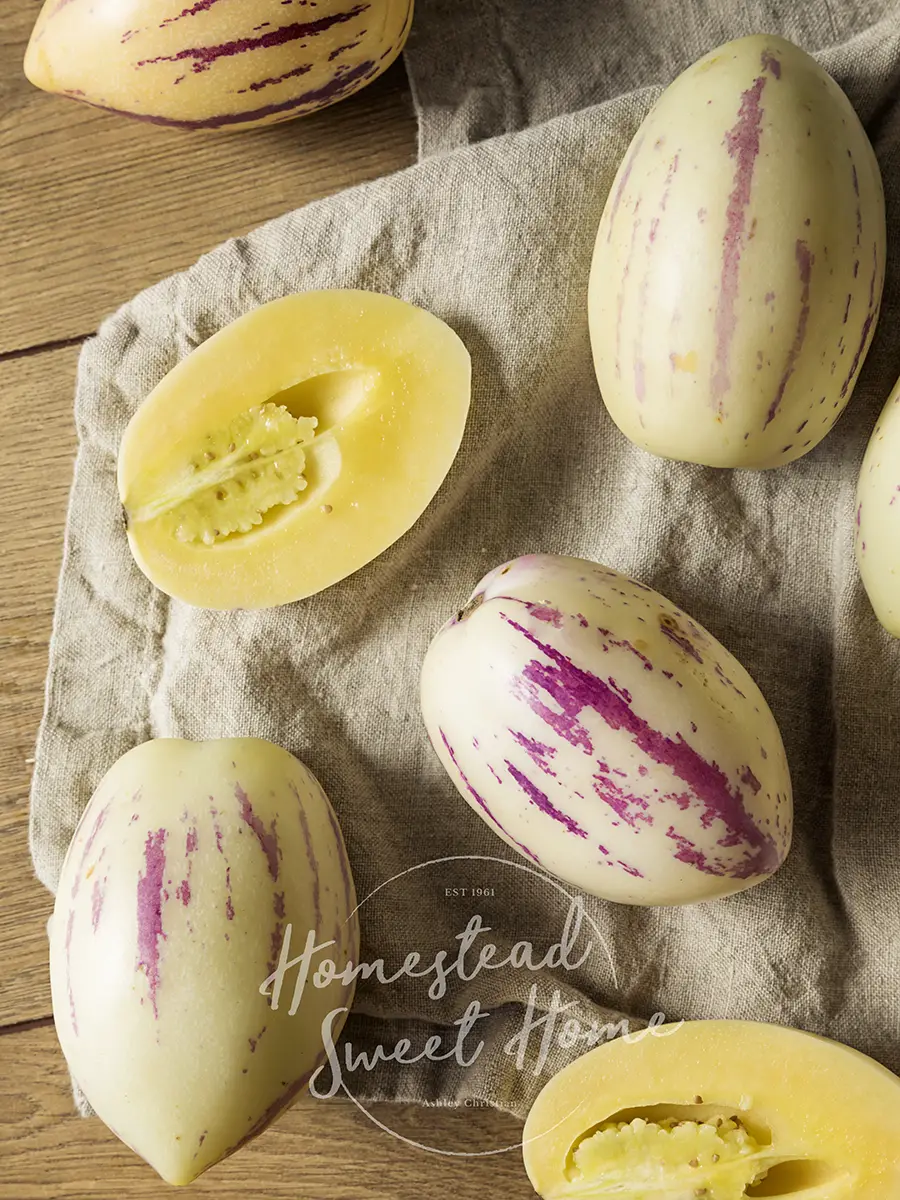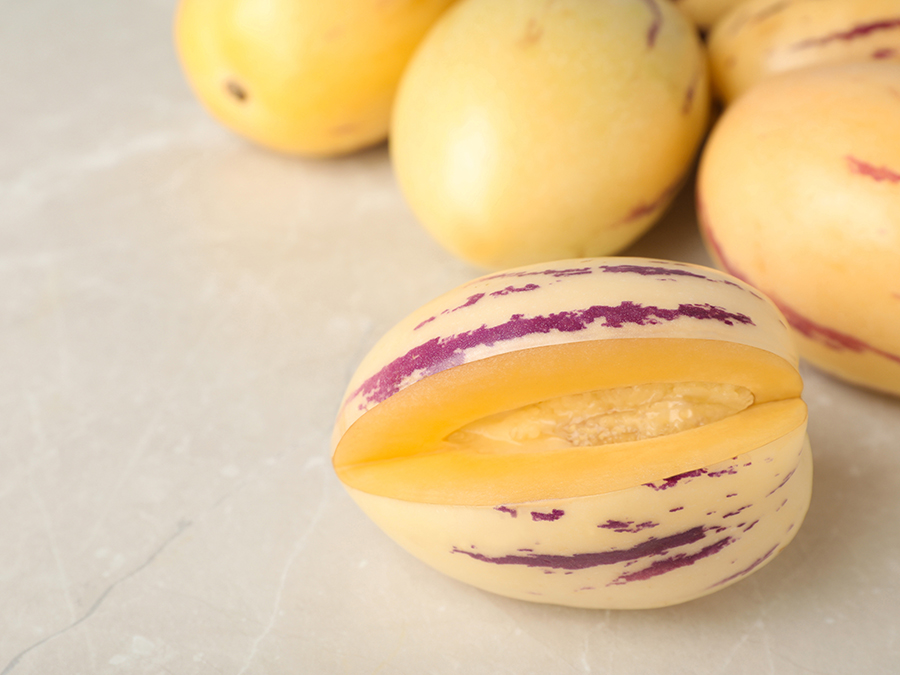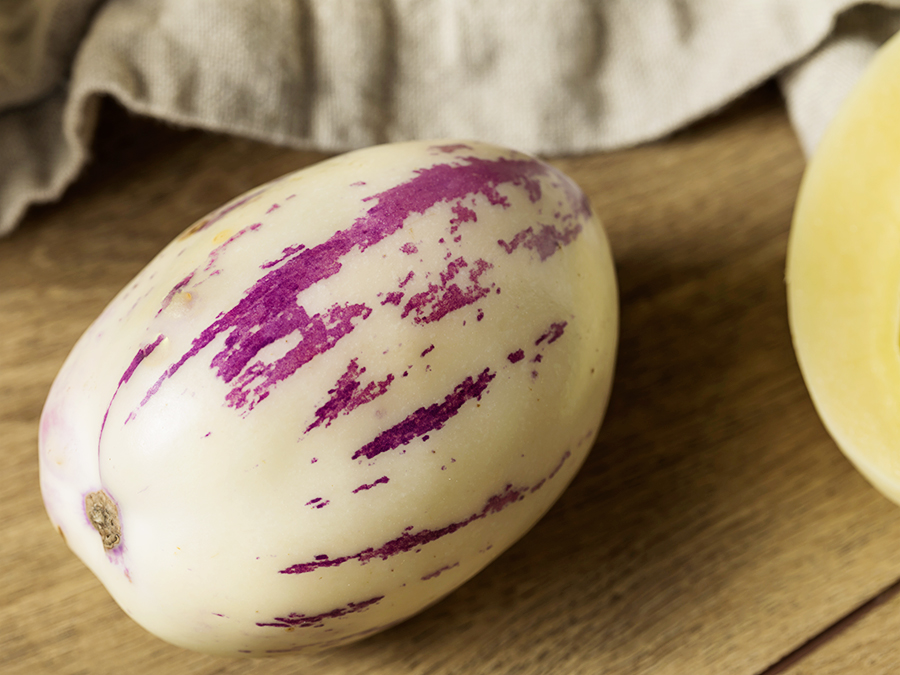Pepino Melon — How to Grow it in any Climate

The Pepino melon is actually not a melon but fruit from the nightshade family similar to tomatoes, potatoes, eggplants, and peppers. It’s called a melon though because of its melon-like flavor. It is best grown in USDA hardiness zones 9-13, as a perennial, but can also be grown as an annual in climates with more frost by starting indoors and overwintering in a greenhouse or inside. Learn how you can grow your own Pepino melon, how to know when it is ripe, and how to eat it.
Pepino Melon Quick Facts
- Botanical Name—Solanum muricatum
- Common Names—Pepino melon, pepino dulce meaning sweet cucmber, and melon pear
- Plant Type—perennial fruit in warm climates or wintered in a greenhouse, though it can be an annual in frost-prone climate if started indoors
- Size—can vine up to 6 1/2 feet tall
- Spacing—½ deep, 18-36 inches between plants, provide a trellis
- Ideal Climate—full sun, USDA Zones 9-11 or indoors in cooler climates, nighttime temps 65 F and up
- Can it Be Started Indoors and Transplanted—yes
- Taste—melon and cucumber
- Growth—6 to 12 months from seed to harvest
- Harvesting—look for fruit 60 to 80 days after the white and purple blossoms appear, harvest when the fruit turns a deep color and is slightly soft to the touch
What is a Pepino Melon?
A Pepino melon is also known as a sweet cucumber, melon pear, or Pepino dulce. These fruits are the size of your palm or about the size of a medium avocado. They can be rounded or pear-shaped, and often appear cream to yellow colored with deep purple striping. Because there or so many different varieties of Pepino melon, not all appear this color, and some are more green without the purple stripping.
The fruit has shiny skin with soft flesh and seeds inside that are pale orange like a cantaloupe. The Pepino melon is a member of the nightshade family and originates from the Andean regions of Columbia, Peru, and Chile.

What Does a Pepino Melon Taste Like and How do You Eat it?
Pepino melons taste similar to a cantaloupe or honeydew melon with a hint of cucumber flavor. They are very light tasting, juicy, and pleasant to eat.
The entire fruit can be eaten, including the skin, much like you would an apple off the branch. However the skin can be a bit tough, so many people like to peel them first, and then eat them. They are great sliced and added to fruit salad, added to cereal, or a yogurt parfait
Underripe Pepino melon can also be baked like you would a squash. Sweet cucumber is also great in smoothies or chopped and added to salsa.
Where Do Pepino Melons Come From?
The Pepino melons are not found in the wild but were domesticated in the temperate areas of the Andes Mountains in Peru, Colombia, and Chile. The fruit was grown in San Diego in 1889 and continues to be grown for upscale markets across the world.
The Pepino melons have slowly been growing in popularity among backyard gardeners. However, they can be difficult to source in North America and are more popular in Europe and Australia. You can often have luck finding Pepino melon seeds or even better, cuttings, in online seed exchanges or small growers on Etsy. You can also order Pepion seeds online from the UK, but keep in mind they will take several weeks to arrive.
How Do I Plant Pepino Melon Seeds?
Seeds—When planting Pepino melon from seed, keep in mind they can take from 6 to 12 months to bear fruit. They also won’t bear fruit unless the nighttime temperatures are 65 F and above. Because of this, you’ll need to plant Pepino melon seeds according to your zone.
Hardiness Zones 1-8
If you are starting a Pepino plant from seed and live in zones 1 through 8, it is best to start it in a pot indoors in the fall or early winter. Pepino melons also do exceptionally well in heated greenhouses during cooler months.
In the late spring when all threat of frost is over, and nighttime temperatures are consistently 65 F and above, you harden off your plants by watering them less and taking them outside for increasing hours each day for a week. This will toughen up your plants to handle the more harsh temperature swings and direct sunlight of the outdoors.
We recommend you leave your Pepino melon bushes in their own pots rather than planting them in the ground in your garden. This will make it easy to carry your plants indoors or into the greenhouse to overwinter them.
Hardiness Zones 9-13
The warmer climates with little risk of frost in zones 9 through 13 are ideal growing
conditions for the Pepino melon plant. You have the option of growing them in the ground, in raised beds, in pots, and even in hanging planters if you’d like. Though if you live in zone 9 and still get some cooler weather, be ready with crop covers to help your outdoor plants along, or bring them inside.

Watering—When you first plant your Pepino melon seeds, whether in the ground or in containers indoors, you’ll need to water them frequently until they germinate. Anywhere from twice a day, to every other day, is good for watering seeds. Decide how often to water by checking the moisture of your soil. You don’t want the soil around your seeds drying out completely, but you also don’t want to drown your seeds. Simply check the soil by sticking your finger to test the moisture and water accordingly.
Once your seeds have germinated and are grown, about one to two weeks after planting, you can begin to water less often. It’s best to water an established garden more deeply and space waterings further apart rather than daily. In general, gardens can be soaked with 1 inch of water or rain once a week. If you get rain, you only need to supplement whatever amount of water is left up to 1 inch of rain.
Soil—Pepino melon plants need good drainage, so you’ll want to make sure you have a good mix of organic compost and high-quality topsoil. Perfect soil should be able to pass the squeeze test. If you squeeze it in your hand, it will hold together. But if you run your fingers through it, it will fall apart.
If your soil is too hard, consider amending it with compost to allow for better drainage and oxygen. If you are using raised beds or tilling soil into your inground garden bed, try one of these soil recipes. Remember, your garden will only be as good as your soil.
There are many different recipes for the best garden soil, but the two most popular are:
- 60/30/10—60% topsoil, 30% compost, and 10% potting soil (this is actually a soilless blend of peat moss, vermiculite, and/or perlite.
- 50/50—50% topsoil and 50% compost
When buying your topsoil, you’ll need to do a little sleuthing to make sure it’s good quality. Signs of high-quality topsoil are:
- Regionally sourced ingredients listed on the bag
- Nationally recognized compost certification on the bag
- Passes the squeeze test, sticks together when squeezed, but then falls apart again when you run your fingers through it
- Is not fill-dirt that some companies mistakenly call top-soil
How do I Grow Pepino Melons From Cuttings?
You can also grow Pepino melon plans from cuttings. These are best found from another home gardener in an online garden group or seed exchange, or from a small seller on Etsy. You can also propagate your own cuttings to add to your home garden, or to share with other gardeners.
Stems from the Pepino melon plant that grows on the ground can naturally propagate themselves. You will find these stems laid on the ground will start growing roots of their own. This is another reason to add a trellis or cage to your Pepino melon plant if you don’t want it making baby plants that take up valuable root space from your mother plant.
You can encourage this self-propagation by laying a few branches from your mother plant on the soil, then loosely covering them. Once they have established a solid root pattern of their own, you can cut the new starts from the mother plant to make it a new Pepino melon plant, and transfer it to a new pot.
If you are able to find Pepino melon plant cuttings, you can either start them in water or in soil. Starting them in soil may take a week longer for them to grow roots than starting in water. Starting your cuttings in water is also fun because you get to watch the process. But either method works well.
If you grow your Pepino melon cuttings in water, you’ll want to place it in a sunny spot near a window, but also without direct sunlight. Make sure to change the water every three to four days. Ensure no leaves are touching the water, you only want your stems in the water. This process should take about two weeks, and then you can transfer your cuttings into a pot with soil or a garden if you live in a warm climate.
If you grow your Pepino melon cuttings in soil, make sure that it drains well. Water your cuttings daily, and place them in a spot that gets plenty of indirect sunlight. Once you have good roots growing about three weeks later, you can move it to a larger pot, or into your garden.
Do I need a Trellis for My Pepino Melon Plant?
The Pepino melon grows like a vining bush, and it is recommended to have a trellis or cage and grow your Pepino melons much like you would tomatoes. The trellis or cage can keep the ripe fruits from weighing down the plant too much. It will also help keep the vines off the ground where they can attract pests or get stepped on.
Since the Pepino melon plant will propagate on its own, it’s also a good idea to use a trellis or tomato cage. When its vines grow and touch the soil, those branches can grow their own root system which will end up crowding your pot and taking up valuable nutrients from the soil. You can either cut these new starts and make new plants or help train them up to your trellis.
If you want to try your Pepino melon in a hanging basket, you don’t need to use a trellis. It will simply grow out and over the hanging basket and give you beautiful flowers and fruits.
How Long Do Pepino Melons Take to Grow?
Since the Pepino melon is a warm-weather perennial plant, it does take longer to grow. You can expect anywhere from six months up to a year to harvest fruit if you have started your Pepino melon from seed. The biggest determining factor in how long your Pepino melon takes to produce fruit is your weather. Pepino melon plants like temperatures of 65 F and above on a consistent basis to really take off. It takes anywhere between 30 to 80 days from the time your plant flowers until it produces fruit.
If you’re struggling to get your Pepino melon plant to grow, the most likely culprit is your temperature. You can try keeping your potted plant inside near a window until your nighttime temperatures are above 65 F. You can also use a heated greenhouse, or garden bed covers depending on your climate. Pepino melon plants can briefly stand temperatures down to 20 F without dying, but this can really slow down the plant’s growth. It’s best to protect your Pepino melon from cold weather as much as possible.
Are you ready to start your first garden, or troubleshoot common garden issues you are having? Check out our Complete Guide to Home Gardening + 5 Beginner Mistakes to Avoid.
What about you, have you ever eaten Pepino melon before, or grown a Pepino melon plant? Let us know your experience in the comments below.


One Comment
CAN IT GROW IN TROPICAL COUNTRY LIKE PHILIPINES